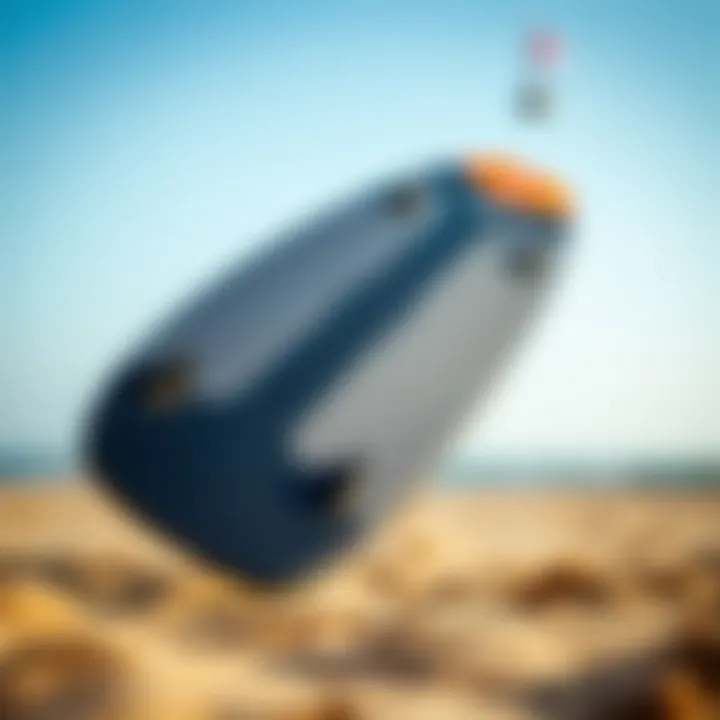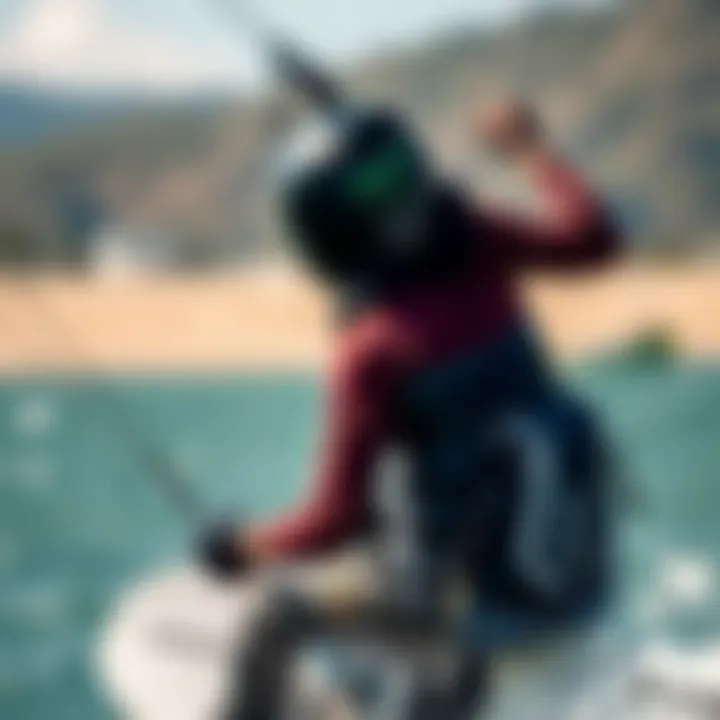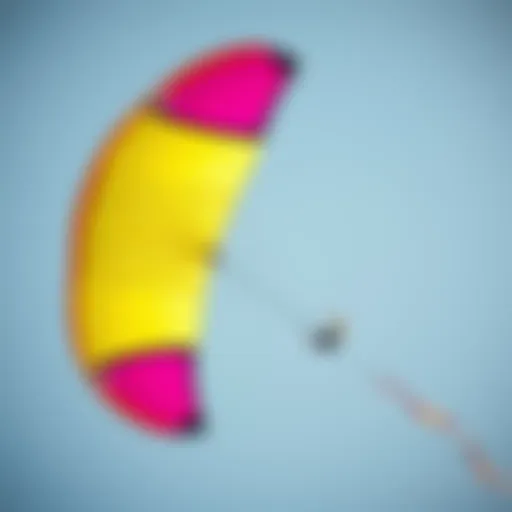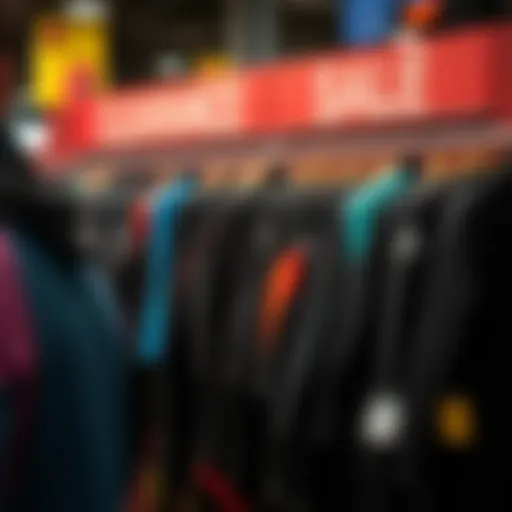Exploring Carbon High Modulus in Kiteboarding Gear


Intro
Kiteboarding has grown from a niche sport to a worldwide sensation, captivating enthusiasts who thrive on the thrill of harnessing wind power. At the heart of this evolution lies the continuous quest for better gear. Among the materials revolutionizing this landscape is carbon high modulus, a substance that has transformed what riders can achieve on the water. The unique properties of carbon high modulus not only amplify performance but also enhance the overall experience of kiteboarding.
This section serves as the gateway to understanding how carbon high modulus materials have cemented their place in the kiteboarding arsenal. As we delve into this innovative material, we'll explore its benefits, applications, and even the potential challenges that come with it. Emphasizing the synergy between technology and craftsmanship, we aim to equip kiteboarders—whether they are beginners or seasoned veterans—with deeper insights about their gear.
The structural integrity, light weight, and responsiveness of carbon high modulus gear have positioned it as a front-runner, making it important for kiteboarders to grasp its significance in both equipment choices and performance outcomes.
Preamble to Carbon High Modulus
The discussion surrounding carbon high modulus materials has surged in recent years, particularly as the adrenaline-fueled sport of kiteboarding continues to evolve. Sprinkling innovation into every facet of gear, these materials hold substantial sway over how enthusiasts experience the water—while riding the wind and waves. Understanding the nuances behind carbon high modulus is essential for anyone involved in kiteboarding, from seasoned riders to budding newcomers, as it influences performance, safety, and adaptability in dynamic conditions.
Defining Carbon High Modulus
To grasp the significance of carbon high modulus, one must first decode its very definition. In simple terms, carbon high modulus refers to a type of carbon fiber characterized by its exceptional stiffness and strength. This unique attribute allows it to withstand the rigors of challenging environments, making it an ideal candidate for kiteboarding equipment that demands both durability and lightness. The ‘high modulus’ aspect implies a greater resistance to deformation compared to standard carbon fiber, making it more suitable for high-stress applications.
So how does this translate into practical terms for kiteboarding gear? When creating components like kite frames or boards, manufacturers often opt for high modulus carbon to not just cut down on weight, but enhance responsiveness. Picture a kite that reacts instantly to your steering—this is where carbon high modulus shines, turning mere wind into a symphony of speed and agility underfoot.
Historical Context and Development
The journey of carbon high modulus materials traces back several decades, during which advancements in material science have played a crucial role. Initially, carbon fiber was primarily used in aerospace and high-performance automotive industries due to its strength-to-weight ratio. As technology progressed, kiteboarding manufacturers started to explore its potential, blending innovation with tradition.
In the late 1990s and early 2000s, the kiteboarding industry saw a pivotal shift. Companies began experimenting with advanced materials, attempting to push the envelope further. This was the dawn of lighter and stronger kites, marking a transition from conventional materials like wood and aluminum to more modern composites. The introduction of carbon high modulus represented a game changer, offering unprecedented performance capabilities.
As kiteboarding grew in popularity, the demand for more sophisticated gear surged, prompting research into the applications of high modulus carbon. Today, it plays a central role in the design and manufacture of essential kiteboarding components—enhancing the overall riding experience by providing durability, improved handling, and weight reduction. It is undeniably a cornerstone of modern kiteboarding, empowering riders to push boundaries and achieve new heights.
"Wherever you go in kiteboarding, carbon high modulus is there, fueling your adventures with unmatched precision and power."
In summary, understanding carbon high modulus is vital for anyone engaged in kiteboarding. It shapes not just the gear but the very experience of riding. As we peel back the layers of its applications and implications, we discover a rich landscape of possibilities that enhance performance and redefine what's achievable on the water.
Key Properties of Carbon High Modulus
When it comes to kiteboarding, the demand for equipment that performs under a variety of conditions is always on the rise. This demand is met effectively by carbon high modulus materials, which offer a range of unique properties tailored for performance optimization. Understanding these properties is essential for kiteboarders, manufacturers, and even instructors. From mechanical strength to weight management, each aspect contributes significantly to the overall experience on the water.
Mechanical Strength
Mechanical strength is perhaps the most striking feature of carbon high modulus materials. This property assures kiteboarders that their gear can withstand the immense forces experienced during high-speed maneuvers or when hitting waves. Simply put, it allows an impressive resistance to bending and breaking, which is what separates a sturdy setup from one that could easily falter.
In the context of kiteboarding, this strength translates to added confidence. Riders can push their limits, knowing that their equipment is robust. The design of kite frames, for instance, leverages this strength to create structures that don’t flex excessively, allowing for better control and precision. Riders can execute sharp turns and high jumps without worrying about equipment failure, which enhances both safety and performance.
Weight Considerations
Another pivotal characteristic is the weight of carbon high modulus materials. Lightweight gear provides an edge in kiteboarding. When a kiteboarder is navigating strong winds, every ounce counts. A lighter setup enables faster acceleration and quicker reactions, which can be the difference between mastering a trick and struggling to maintain stability.
Moreover, the reduced weight positively impacts the overall user experience. Users often report feeling more connected to the water with less bulk to maneuver. It also means less energy expended in maintaining speed, allowing for longer sessions without the typical fatigue that heavier materials can impose. Riders can enjoy the freedom of movement that the lightweight nature of carbon high modulus brings.
Durability and Impact Resistance
Durability is an element that cannot be overlooked. Kiteboarding gear is exposed to harsh environments: saltwater, sand, winds, and impacts from jumping or landing on hard surfaces. Carbon high modulus materials hold up remarkably well against such challenges. They resist wear and tear much better than many traditional materials, which can result in significant cost savings over time.
Moreover, their impact resistance means fewer worries when navigating through choppy waters or when gliding down from a jump. If materials are resilient to impacts, they minimize the risk of breakage which often leads to equipment costs piling higher. Riders can venture into rougher waters with the assurance that their gear is built to last, which beckons for a more adventurous style of kiteboarding.


"The strength and durability of carbon high modulus materials provide kiteboarders peace of mind, allowing them to focus on their performance rather than their equipment."
In summary, the key properties of carbon high modulus materials not only enrich the kiteboarding experience but also enhance performance, safety, and longevity of gear. Kiteboarders looking to invest in high-quality equipment should definitely consider these factors as they browse through various options.
Applications in Kiteboarding Gear
When we talk about kiteboarding gear, it’s crucial to focus on applications of carbon high modulus materials. The ability to harness their unique properties has reshaped how gear is designed and performs on the water. Kiteboarding enthusiasts, from seasoned pros to weekend warriors, can all benefit from this advanced material. The applications range widely, touching on kite frames, control bars, boards, fins, and harnesses. Each component plays a vital role in performance and overall user satisfaction.
Kite Frames and Structure
Kites are the heart of kiteboarding, and their frames dictate handling and durability. Using carbon high modulus in kite frames results in lightweight structures that don’t skimp on strength. Riders gain a competitive edge with faster response times and increased power retention. This is especially noticeable in gusty winds, where stability becomes a game-changer. The rigidity of carbon high modulus translates to kites that maintain form in challenging conditions, reducing the chance of accidental deformations during high-stress situations.
Another impressive aspect is how these kite frames can reduce drag. A lighter and stiffer frame allows riders to glide through the air more efficiently. With less effort, they can carve their way through the water, relishing each turn like a maestro conducting a symphony of waves and wind.
Control Bars and Lines
Control bars are the connection between the kite and the rider, so it's no surprise that the materials used here are just as vital. Carbon high modulus lines offer enhanced performance through minimal stretch and greater resistance to abrasion. This means every input from the rider is translated with remarkable accuracy, turning thoughts into actions fluidly.
Riders often overlook the importance of weight in control systems, but with lighter materials, you can avoid fatigue during long sessions. No more tired arms, just pure kiteboarding bliss. The added control enhances responsiveness and handling while navigating tricky wind conditions.
"The best storms bring out the best kiteboarders—quality equipment makes all the difference."
Boards and Fins
Boards are another area where carbon high modulus shines. They combine strength with a lightweight build, directly impacting maneuverability and speed. The construction techniques allow for tighter flex patterns, which contribute to better pop during jumps. Riders experience an explosive lift, transforming their skill levels into new heights.
Fins manufactured from carbon high modulus offer additional benefits. Their design not only provides grip but also reduces drag significantly, meaning less resistance against the water. Board-surfing becomes more fluid and enjoyable; riders can carve effortlessly through the waves like a hot knife through butter. A board with enhanced performance can turn mediocre tricks into breathtaking displays.
Harnesses and Accessories
Harnesses are crucial in kiteboarding, as they connect the rider securely to the kite while allowing for freedom of movement. Using carbon high modulus in harness construction helps achieve optimised weight without sacrificing comfort or support. Interestingly, lightweight harnesses improve responsiveness, letting riders focus solely on their maneuvers.
Accessories, too, can benefit from high modulus carbon. Items like safety leashes or even storage solutions become more durable while keeping weights down. This ensures that your entire kiteboarding experience is streamlined and simplified.
Benefits of Using Carbon High Modulus in Kiteboarding
The incorporation of carbon high modulus materials into kiteboarding gear brings forth a multitude of advantages that significantly elevate both the performance of equipment and the overall experience for kiteboarders. This section will dissect how these materials contribute to improved functionality and user satisfaction while addressing some critical considerations.
Performance Enhancement
When we talk about performance in kiteboarding, the phrase "every second counts" rings true. Carbon high modulus has a remarkable ability to enhance the responsiveness of kites and boards. The high stiffness-to-weight ratio of this material means that kiteboards react faster to changes in rider input and wind conditions. Riders can execute sharp turns, sudden stops, and rapid accelerations, considerably more efficiently. In a sport where conditions can change in a heartbeat, having equipment that keeps pace with rider demands is invaluable.
Moreover, the way these boards glide through water can’t be understated. A high modulus carbon kiteboard cuts through waves with ease, thanks to its superior rigidity, which translates into a smoother ride. One experienced kiteboarder mentioned how switching to a high modulus carbon board allowed him to go faster and jump higher than he ever thought possible. Not just a slight improvement, it was a game-changer.
In addition to agility, these boards often have longer lifespans compared to their fiberglass counterparts due to the inherent properties of the material, which means they can withstand rigorous use without compromising performance.
Improved User Experience
User experience in kiteboarding encompasses everything from comfort to confidence in equipment. When kiteboarders feel that their gear works in harmony with them, their enjoyment of the sport skyrockets. Carbon high modulus materials, due to their lightweight nature, offer a more intuitive feel. Riders report less fatigue over longer sessions—a definite perk for those who enjoy marathon kiteboarding days.
The construction of harnesses that incorporate these materials also provides better weight distribution, enhancing comfort and minimizing pressure points. Comfortable gear means you can focus on what matters: the riding. Riders, both beginners and seasoned enthusiasts, often express that their enhanced tether to the wind and water can be attributed to the lightweight feel of their carbon high modulus gear. This isn’t merely anecdotal; the difference manifests in less muscle strain and improved handling, ensuring that kiteboarding remains enjoyable rather than exhausting.


Long-Term Cost Efficiency
At first glance, one might balk at the price tag attached to carbon high modulus equipment. However, in the long term, investing in this cutting-edge technology can lead to significant savings for kiteboarders. Due to their durability, boards made from carbon high modulus often outlast their fiberglass or other composite counterparts. They resist wear and tear better, which means less frequent replacement—an important factor for budget-conscious adventurers.
Additionally, maintenance costs are usually lower for carbon high modulus gear. The material’s resistance to flexing means fewer repairs and a longer lifespan. Investing in quality gear not only improves performance but also can protect the wallet in the long run. Ultimately, a kiteboarder who opts for carbon high modulus gear could find themselves spending less over years of riding while benefitting from enhanced performance and comfort throughout.
"In the world of kiteboarding, choosing gear made with carbon high modulus materials is worth every penny in the long run. You invest in quality, and in return, you experience performance that keeps giving back session after session."
From enhancing performance and providing a comfortable ride to ensuring long-lasting value, the benefits of using carbon high modulus in kiteboarding cannot be overlooked. Strong, lightweight, and user-friendly are words that seem to define both the kiteboards and the experience they provide, ushering in a new era for kiteboarders eager to take their sport to new heights.
Challenges and Limitations
Understanding the challenges and limitations of carbon high modulus materials in kiteboarding is vital. While these state-of-the-art materials offer a multitude of advantages—like increased strength and reduced weight—they also come with their own set of issues that users need to grapple with. Grasping these nuances can significantly influence purchasing decisions and product designs, ensuring that kiteboarders get the best bang for their buck.
Cost Considerations
When it comes to carbon high modulus, the first hurdle that often surfaces is the cost. These materials tend to be pricier than traditional options like fiberglass. The high price tag can be a real sticking point for hobbyists or those just starting in the sport. For instance, while a decent fiberglass kiteboard might set you back a few hundred dollars, a comparable board made of carbon high modulus could easily cost double or even triple that amount.
- Investment vs. Value: It’s not just about the price; it’s about value over time. Kiteboarders who make the investment in high modulus materials often benefit from enhanced performance and longer-lasting gear, which can justify the initial expense.
- Market Accessibility: Unfortunately, the elevated costs can restrict access for the average traveler or adventurer. Not every kiteboarder wants to break the bank, which can sometimes limit the push for further innovations in manufacturing.
- Replacement and Repair: Additionally, if these materials do suffer damage, repairs can also pinch the wallet. Unlike fiberglass, which can often be patched up affordably, high modulus materials may require specialized repair services, leading to escalated costs.
Ultimately, understanding the cost implications is essential for anyone serious about kiteboarding. It’s a balancing act of budget management against the performance gains offered by premium materials.
Manufacturing Complexity
The second hurdle relates to the manufacturing complexity. Producing carbon high modulus items isn't as easy as pie. The process demands advanced technology and skilled labor, which compounds the costs already discussed.
- Specialized Techniques: Creating these high-performance components often involves sophisticated techniques like resin transfer molding or prepreg lamination. Not every manufacturer has the capability to implement such advanced processes, which can limit the availability of high modulus products.
- Quality Control: The increased complexity of manufacturing also heightens the need for rigorous quality control. Bad batches can lead to significant safety concerns during use, especially when the equipment is put under considerable stress.
- Supply Chain Issues: Furthermore, the materials needed for production are sometimes harder to source. This can create bottlenecks in supply chains, resulting in delayed product launches or limited inventory, which can frustrate eager kiteboarders.
Given these complexities, movers and shakers in kiteboarding must weigh the benefits of advanced materials against the manufacturing challenges. Making informed choices here is key to achieving success in both performance and customer satisfaction.
Comparative Analysis with Other Materials
In the realm of kiteboarding, understanding the various materials that go into equipment construction is key to unlocking the most potent performance and durability. A comparative analysis helps kiteboarders to make educated choices about gear that aligns with their riding style, preferences, and budgets. With ever-evolving advancements in technology, knowing how carbon high modulus stacks up against competitors like fibreglass and traditional materials can lead to richer experiences on the water. Here, we dig into how these materials differ, not only in performance but also in broader implications for kiteboarding enthusiasts.
Carbon Fiber vs. Fiberglass
Carbon fiber and fibreglass represent two prominent materials in kiteboarding gear, each bringing distinct characteristics to the table. When comparing them, a few specific elements deserve attention:
- Weight and Performance: Carbon fiber is known for its high strength-to-weight ratio, making it lighter and often resulting in improved agility during maneuvers. In contrast, while fibreglass is more affordable, it tends to be heavier, which can hinder performance, especially when jumping or executing sharp turns.
- Cost Considerations: Fibreglass has long been the budget-friendlier option, favored by beginners. However, the initial savings might come at the expense of longevity, as fibreglass products can wear out more quickly compared to their carbon counterparts. That said, the upfront lower cost of fibreglass might appeal to those just starting out.
- Resilience and Durability: Even though fibreglass offers decent flexibility, it lacks the sheer resilience of carbon fiber against impacts. Carbon fiber can take a beating and come out relatively unscathed, ensuring that gear remains intact through tough conditions.
"Choosing the right material for your kiteboarding gear can significantly impact both performance and safety on the water."
- Repairability: Fibreglass is generally easier to repair than carbon fiber, which may be a consideration for adventurous kiteboarders who often find themselves in challenging environments. Many riders are comfortable working with fibreglass, while carbon fiber repairs might require professional help or specialized tools.
Carbon High Modulus vs. Traditional Materials
When we talk about traditional materials, these often include wood and metals that have been utilized for years in the sport. Here's how carbon high modulus enhances the kiteboarding experience over these older options:
- Performance Metrics: One of the standout features of carbon high modulus is its unparalleled stiffness coupled with weight savings, leading to enhanced responsiveness. Wood may provide rigidity but often lacks the precision necessary for advanced techniques that carbon high modulus can support.
- Corrosion Resistance: Traditional metallic materials can rust and deteriorate over time, particularly in marine environments. Carbon high modulus does not suffer from corrosion, making it a practical choice for gear exposed to saltwater conditions.
- Environmental Factors: Older materials might not adapt well to variations in temperature and humidity. Carbon high modulus, on the other hand, retains its structural integrity under duress, ensuring consistent performance no matter the conditions, which is paramount for kiteboarders seeking a reliable ride.
- Weight-Saving Innovations: In the past, riders often had to compromise between sturdiness and weight. With carbon high modulus, kiteboarders now have the opportunity to enjoy lightweight yet robust gear, which directly translates to better control and an exhilarating riding experience.
- Aesthetic Satisfaction: Finally, many enthusiasts are drawn to the sleek and modern look of carbon high modulus components, making their gear not only functional but also stylish.
Future Trends in Material Innovation


The realm of kiteboarding is continuously evolving, and with that evolution comes the need to stay ahead of the curve in material advancements. Understanding future trends in material innovation is critical not just for manufacturers but also for kiteboarders who seek to enhance their performance on the water. As technology strides forward, various innovations promise to redefine the dynamics of how kiteboarding gear is constructed and utilized. This section sheds light on the emerging trends that signal exciting developments in kiteboarding equipment.
Advancements in Nanotechnology
Nanotechnology is paving the way for remarkable improvements in material properties. By manipulating materials at the molecular level, manufacturers can create composites that are lighter and stronger than ever before. For kiteboarding, this means gear that offers superior performance without the added bulk.
- Lightweight Performance: By reducing the weight of materials used in kite frames or boards, kiteboarders can achieve greater agility and speed. A lighter board can allow for quicker maneuvers, allowing riders to push their limits.
- Enhanced Strength: The strength-to-weight ratio improves significantly with nanomaterials. This is particularly valuable in environments where equipment is subjected to high stress or impact, reducing the risk of breakage during intense sessions.
- Weather Resistance: Nanotechnology can also enhance the resistance of materials to environmental factors. Whether it's UV radiation from the sun or salty ocean spray, innovations in nanoparticles can protect gear and prolong its lifespan.
Nanotechnology doesn't just promise better gear; it leads to more engaging experiences on the water, making it easier for riders to explore their potential, tackle challenging conditions, and elevate their skills.
Sustainability in Material Selection
In recent times, sustainability has emerged as a vital concern across industries, kiteboarding included. As communities become increasingly aware of environmental impacts, selecting sustainable materials in gear production is not just an option; it's becoming a responsibility.
- Eco-Friendly Materials: Manufacturers are beginning to experiment with natural fibers and recycled materials that reduce reliance on virgin plastics and other non-renewable resources. Choosing such materials helps minimize the carbon footprint associated with production and distribution, aligning the sport with ecological preservation.
- Biodegradable Options: Some innovators are on a mission to produce biodegradable kiteboarding gear. This can significantly reduce waste in oceans and landfills after the equipment's life cycle ends, protecting marine habitats crucial to our oceans' health.
- Responsible Manufacturing Practices: By prioritizing sustainable practices in production and supply chains, brands can ensure they are not only providing top-tier gear but also contributing positively to the planet.
Taking steps towards sustainability can amplify the kiteboarding community's image as one that respects and protects the environment. For enthusiasts and adventurers who cherish open water and nature, knowing that their gear aligns with their values enhances the overall experience.
Ultimately, as kiteboarding continues to soar, staying informed about trends in material innovation can lead to better choices for riders that support performance, sustainability, and longevity in their gear. As consumer awareness grows and eco-conscious practices advance, the future of kiteboarding looks brighter both on and off the water.
"The true beauty of kiteboarding lies in the freedom and connection to nature. As we evolve our materials, we must also protect the elements that draw us to the sport." - Anonymous Kiteboarder
For more insights on material innovation in outdoor sports, consider exploring these resources: Wikipedia - Kiteboarding, National Park Services - Outdoor Ethics, Environmental Protection Agency - Sustainable Materials Management.
User Perspectives and Experiences
The significance of user perspectives in the discourse surrounding carbon high modulus materials cannot be understated. Kiteboarding is not merely a sport; it's a community, a culture where experiences and individual stories shape the understanding of technological advancements. The insights from actual users, kiteboarders, and instructors provide a well-rounded view that complements the technical attributes of carbon high modulus materials. Rather than relying solely on manufacturer claims, these testimonials bring a human element to the conversation, shedding light on how such materials truly impact performance and experience on the water.
Testimonials from Kiteboarders
When delving into the realm of kiteboarding, the words of kiteboarders resonate strongest. Many have praised carbon high modulus materials for their exceptional performance and responsiveness. For instance, a kiteboarder might share how their new carbon high modulus board drastically improved their maneuverability, allowing sharper turns and quicker reactions in varying wind conditions. One kite enthusiast, Sarah, highlighted, "Switching to a carbon high modulus board felt like upgrading from a bicycle to a sports car. The speed and agility were night and day."
Another kiteboarder, Tom, echoed similar sentiments, specifically about the durability aspect: "With carbon high modulus, I've been through storms and crashes, and my gear stands up to it all. It's like my gear has a superpower!"
Such remarks are immensely valuable since they emphasize the material's ability to enhance not only performance but also the overall enjoyment of the sport. Kiteboarders emphasize their proclivity for lightweight gear as well; after all, battling the ocean's might is more enjoyable with equipment that feels effortlessly light. Testimonials often illustrate that the jump from traditional materials to carbon high modulus results in less fatigue and ultimately longer sessions on the water.
Aditionally, a common thread among kiteboarders is the notion of investment. Users often consider the initial cost as just that — an investment. One passionate rider stated, "Sure, the upfront cost is higher, but the performance and lifespan give me much better value than those cheaper options. You get what you pay for, right?"
Expert Insights from Instructors
Instructors play a crucial role in shaping the kiteboarding community, and their insights add yet another layer to understanding carbon high modulus materials. Experienced instructors tend to notice patterns emerging from their students, often relating back to the advancement in gear technology. "Students using carbon high modulus boards find it easier to pick up tricks and techniques. It really boosts their confidence," remarked Matt, a seasoned kiteboarding instructor.
When instructors speak of reliability, it often ties back to the materials they advocate for. A frequent topic during initial lessons is durability. In a sport that often involves learning through falls and mistakes, having reliable equipment can mean the difference between retaining interest or feeling discouraged. An instructor named Natalia shared, "With everything else that's going on during lessons, it's a relief to know I won't be worrying about gear breaking. Carbon high modulus changes the game there."
Instructors also observe that carbon high modulus gear can adapt to a variety of skill levels. This flexibility allows novice kiteboarders to progress without constantly needing to upgrade their equipment, which to many, is a significant factor in the early stages of learning. For expert riders, the material helps in fine-tuning their performance and achieving goals.
"The gear you use becomes an extension of yourself; with the right materials, you can truly soar."
For more discussions and perspectives on kiteboarding, resources such as Reddit provide platforms for enthusiasts to share their personal experiences and insights.
Closure and Final Thoughts
In the realm of kiteboarding, the integration of carbon high modulus materials has marked a significant advancement in gear technology. This section serves not only as a wrap-up of the discussed themes but also underscores the urgency of adapting to innovative materials as the sport continues to evolve. Understanding the importance of carbon high modulus in kiteboarding gear can help enthusiasts make informed choices, enhancing both their performance and enjoyment.
The material's noteworthy properties, such as its incredible strength-to-weight ratio and resilience, have made it a popular choice for various components of kiteboarding equipment. Kite frames benefit from the stiffness that allows for better kite responsiveness, while boards and fins gain increased durability without adding unnecessary weight. These enhancements translate to an overall superior experience for riders, whether they're beginners or seasoned veterans.
However, to embrace this technology, there are considerations that must not be overlooked. The cost associated with carbon high modulus materials can be a stumbling block for some. This means that while the performance benefits are enticing, budget constraints play a critical role in gear selection. Likewise, the complexity involved in the manufacturing process can make these products less accessible.















